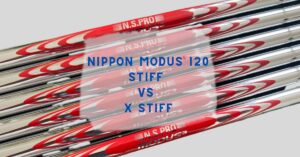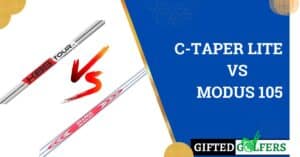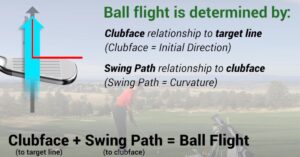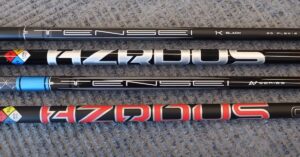N.S. PRO Modus 115 vs 120: Which Golf Shaft Will Help You Improve Your Swing?
The N.S. PRO Modus 115 and 120 are both high-quality steel golf shafts but with distinct differences. For golfers looking for distance, the Modus 115’s reduced weight encourages a higher launch and enhanced clubhead speed. However, the Modus 120 is heavier, providing more stability and control, making it ideal for people who value precision and consistency above all else.
In this modus 115 vs 120 guide, we will compare Modus 115 and 120 to help you understand their differences and make an informed decision.
N.S. PRO modus 115 vs 120: What are the differences?
N.S. PRO Modus 115 and 120 are both popular golf shafts manufactured by Nippon Shaft, a Japanese company known for producing high-quality steel shafts.
While both shafts are designed to provide consistent performance and control, they have a few differences that cater to different types of players and swing styles:
| Feature | N.S. PRO Modus 115 | N.S. PRO Modus 120 |
| Weight | 115 grams | 120 grams |
| Flex Options | Regular (R), Stiff (S) | Regular (R), Stiff (S), X-Stiff (X) |
| Trajectory | Slightly higher | More penetrating |
| Bend Profile | Slightly softer tip section | Stiffer tip section |
| Feel | Smoother | More stable/solid |
| Spin | Slightly higher spin rates | Lower spin rates |
| Swing Weight | Lighter swing weight | Heavier swing weight |
| Torque | Higher torque rating | Lower torque rating |
| Price | Usually less expensive | Usually more expensive |
Weight
The most noticeable difference between the two shafts is their weight. As their names suggest, the Modus 115 is lighter, weighing around 115 grams, while the Modus 120 weighs around 120 grams. The difference in weight can impact a golfer’s swing speed, tempo, and feel.
Flex
The Modus 115 is available in two flex options: Regular (R) and Stiff (S), while the Modus 120 comes in three flex options: Regular (R), Stiff (S), and X-Stiff (X).
The availability of an X-Stiff flex in the Modus 120 is designed for golfers with faster swing speeds who require additional stability and control.
Modus 115 Flex
Credit | nipponshaft
Modus 120 Flex
Credit | nipponshaft
Trajectory
The Modus 115 is known for producing a slightly higher trajectory compared to the Modus 120.
Golfers who prefer a higher ball flight and softer landing may prefer the Modus 115, while those who desire a more penetrating ball flight with lower spin might opt for the Modus 120.
Bend Profile
The Modus 115 has a slightly softer tip section, which contributes to the higher ball flight.
The Modus 120 has a stiffer tip section, offering more control and stability for golfers with faster swing speeds.
Feel
Some golfers may notice a difference in feel between the two shafts due to their weight and bend profile differences.
The lighter weight and softer tip of the Modus 115 provide a smoother feel, while the Modus 120 might feel more stable and solid.
Spin
The Modus 115 typically produces slightly higher spin rates compared to the Modus 120, due to its softer tip section and higher ball flight.
The Modus 120 generates lower spin rates, which can be beneficial for players seeking more control and a more penetrating ball flight.
Swing weight
The difference in weight between the Modus 115 and 120 can also affect the overall swing weight of the club.
A lighter shaft like the Modus 115 may result in a lighter swing weight, which can make the club feel more agile and easier to swing.
On the other hand, the heavier Modus 120 may result in a heavier swing weight, which some players may find more stable and controlled through the swing.
Torque
Torque is the resistance of the shaft to twisting during the swing. Generally, a lower torque rating indicates less twisting and a more stable shaft, while a higher torque rating suggests more twisting and a softer feel.
The Modus 120 typically has a slightly lower torque rating compared to the Modus 115, offering more stability and control for faster swing speeds.
Price
There might be a slight difference in price between the two shafts, with the Modus 120 usually being a bit more expensive than the Modus 115.
However, this can vary depending on the retailer or any promotions being offered.
N.S. PRO modus 120 vs 115: Which Golf Shaft to choose?
When choosing between the N.S. PRO Modus 115 and 120, consider your swing speed, desired ball flight, and feel preferences.
Opt for the Modus 115 if you have a moderate swing speed, prefer a higher ball flight with slightly more spin, and value a smoother feel.
Choose the Modus 120 if you have a faster swing speed, desire a more penetrating ball flight with lower spin, and prefer a more stable, solid feel.
Ultimately, it is essential to test both shafts and select the one that best suits your game.
FAQs
Can the Modus 115 and Modus 120 shafts be used in both irons and woods?
While both shafts are primarily designed for irons, they can also be used in hybrid clubs. However, they are not recommended for use in drivers or fairway woods.
How do the Modus 115 and Modus 120 shafts affect ball flight?
The Modus 115 shaft promotes a higher ball flight with increased spin, while the Modus 120 shaft delivers a mid-launch trajectory with moderate spin, allowing for more control and accuracy.
Can I customize my clubs with the Modus 115 or Modus 120 shafts?
Yes, many club manufacturers and custom club fitters offer the option to customize your irons with either the Modus 115 or Modus 120 shafts.
How do the Modus 115 and Modus 120 shafts compare to other popular golf shafts?
Both shafts are highly regarded in the golf industry for their performance and quality. They can be compared to other high-quality steel shafts from leading manufacturers like True Temper, KBS, and Project X.






